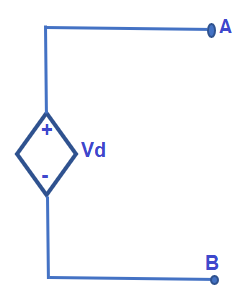Dependent Voltage Source is a four terminal source whose output voltage is dependent on circuit current or voltage. Unlike ideal voltage source, the magnitude of voltage output of this source is not constant. Rather, it is linearly related to input current or voltage. In fact, the output voltage of dependent voltage source is a scalar multiple of its input current or voltage. Let us discuss the concept of dependent voltage source in detail with the help of circuit diagram.
Dependent Voltage Source is also known as controlled voltage source. This is because, the output is controlled by circuit current or voltage. It is denoted by a diamond in an electrical network. Though it is a four-terminal device, it is usually shown by two terminals. Typically, it is denoted as shown below.

As discussed, the output voltage of dependent voltage source depends on circuit current or voltage. Based on this, there are two types of dependent voltage source:
- Voltage Controlled Voltage Source (VCVS)
- Current Controlled Voltage Source (CCVS)
Voltage Controlled Voltage Source (VCVS):
It is defined as the source whose output voltage depends on the voltage across some circuit element. This output voltage is a scalar multiple of the input voltage. VCVS is denoted as shown below.

The voltage Vo is dependent on input voltage Vi. Output Vo is k times the Vi. Here, “k” is a constant. The value of k = (Vo / Vi). Thus, this scaling factor k is dimension less quantity.
An ideal transformer is an example of VCVS. Output voltage in ideal transformer is secondary voltage (V2) and input controlling voltage is the primary voltage (V1). Using transformation ratio,
V2 = (N2/N1)V1
= kV1
Where k = (N2/N1) is secondary to primary turn ratio. Thus, the output voltage is controlled by the input voltage and hence it is a voltage controlled voltage source.
Current Controlled Voltage Source (CCVS)
It is defined as the electrical source whose output is dependent on circuit current. Line VCVS, the output voltage of CCVS is a scalar multiple of input current. It is also a four terminal device with two input terminal and two output terminals. CCVS is shown below.

It can be seen from the above diagram that, output voltage of CCVS is linearly related with the input current. In fact, this scaled by some constant α. “Vo” (output) is α times the “i” (input current). This scaling factor α = (Vo / i). Therefore, the unit of scaling factor of CCVS is volt/ampere.